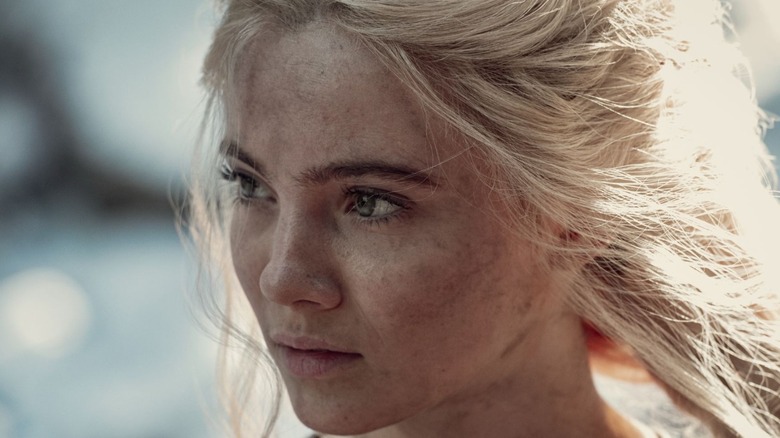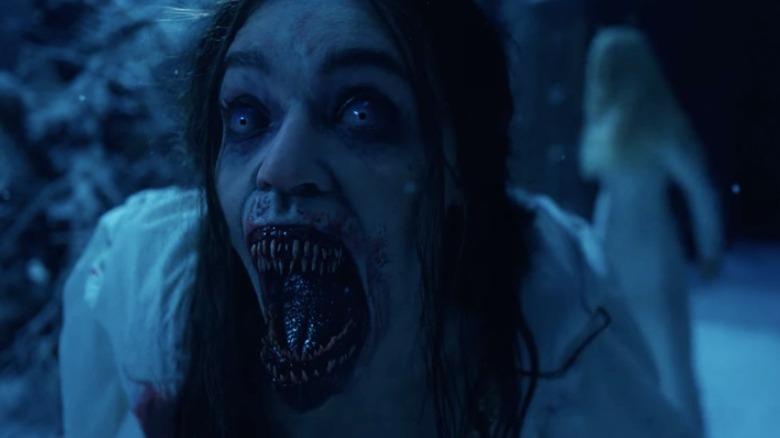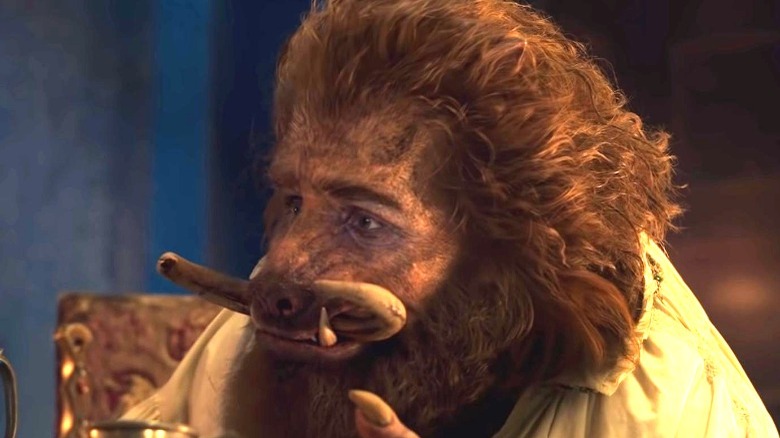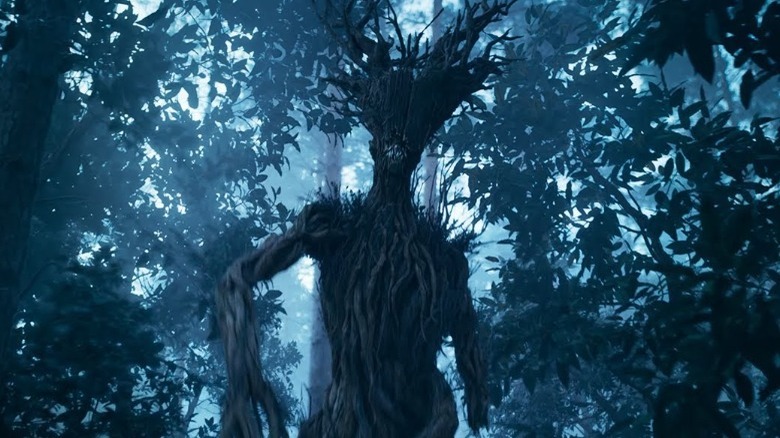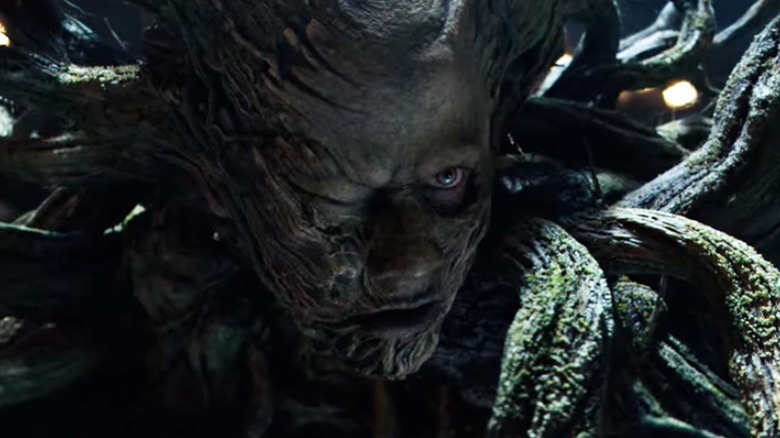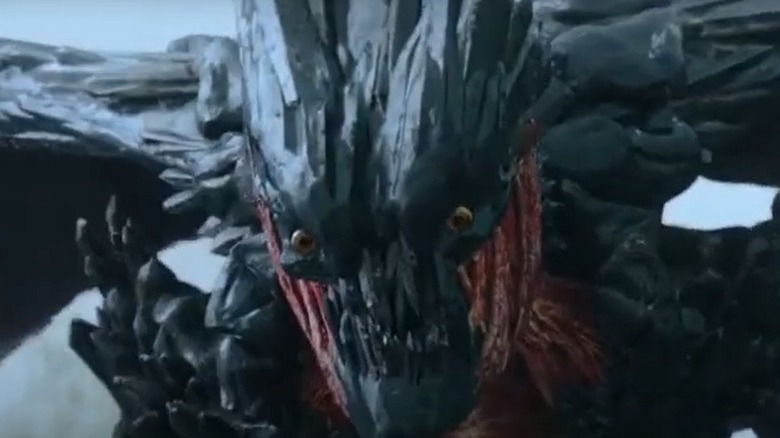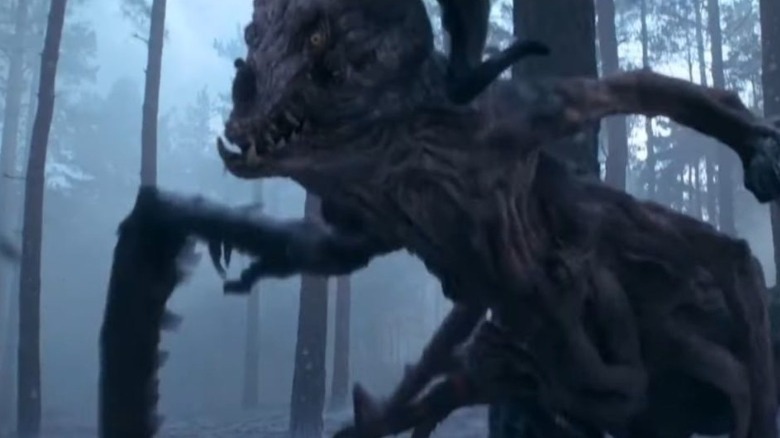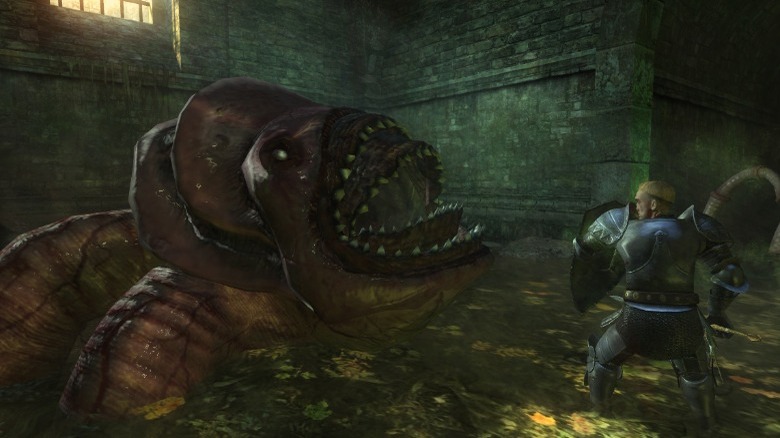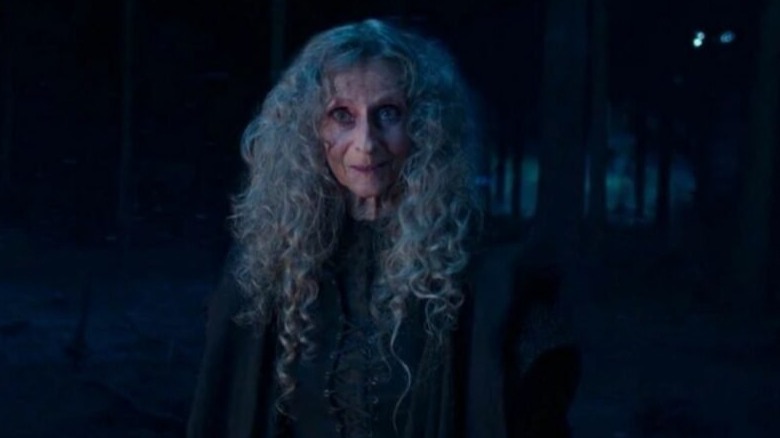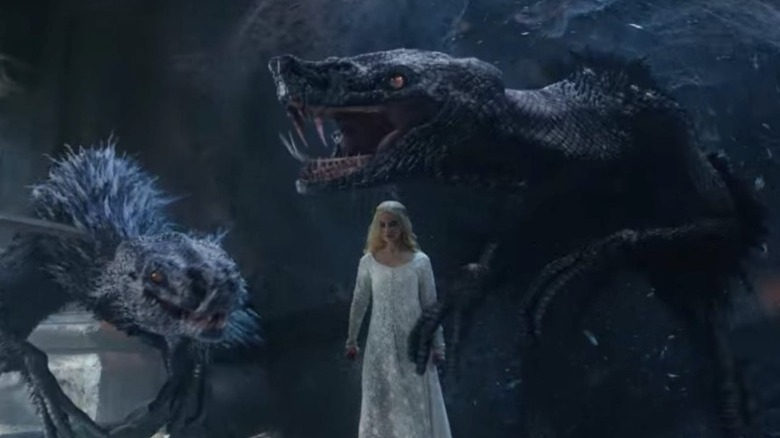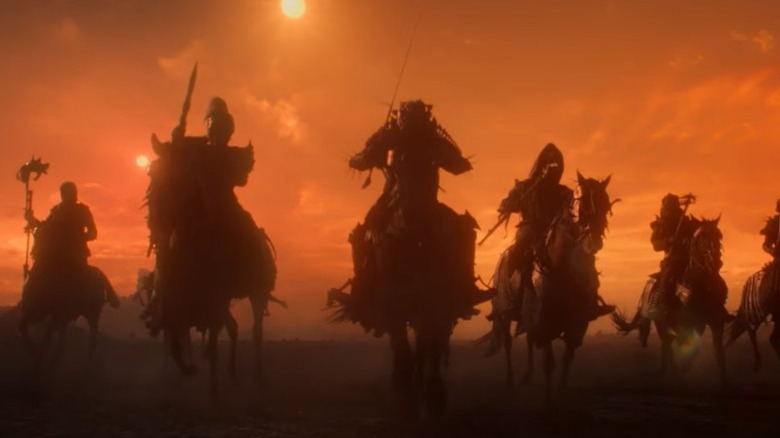All The Monsters In The Witcher Season 2 Explained
This article contains spoilers for "The Witcher" show, books, and video games.
A Witcher is only as formidable as the beasts he slays, and the world of "The Witcher" is teeming with fantastical wildlife that is capable of gutting or snacking on an unsuspecting human in seconds. Enter the Witcher: A highly trained and mutation-throttled warrior whose reflexes and senses are heightened and capable of repelling the beasts as needed. Of course, the nature and origin of a monster are what truly guide Geralt's blade. The White Wolf never seeks to kill a creature for simply being the beast that it is — a monster must truly pose an immediate threat to those around it. Additionally, Geralt gives pause when considering that the target may also be the victim of a curse or an infection.
The lore behind "The Witcher" runs deep across several real-world mythologies. The creator and author behind the novels, Andrzej Sapkowski, has gone on the record via Literary Hub stating, "It would be easier to name the mythologies and cultures I didn't draw on." The monsters that populate the world are derived from Slavic, Germanic, Arabic, Greek, Japanese, and Scottish cultures, among many others. Sapkowski was even inspired by the works of J.R.R. Tolkien and the Brothers Grimm. With a wildly varied bestiary on Geralt's hands and still ever-growing with the advent of the mysterious monoliths connecting the world to other "spheres," there's a lot of work to be done. Let's delve into some of the monstrosities Geralt and crew encounter during their Season 2 adventures.
Bruxa
Kicking off the season with a heavy-hitter, Geralt finds that his friend Nivellen's compound isn't as warm and inviting as once thought when it's revealed that he has been offering safe harbor to a wild and vicious Bruxa. Simply put, a Bruxa is a vampire. Most often, the Bruxa takes on the appearance of a young woman, as indicated in the show. Their offensive capabilities include an ear-shattering scream that packs a physical wallop and sends its targets flying off their feet. Unlike other forms of vampires, a Bruxa is not vulnerable to sunlight. Furthermore, they're undetectable by the Witcher medallions, which explains why she was able to sneak past Geralt for so long. Her ultimate form is that of a giant bat-like creature, which Geralt has to contend with as it swoops in and out of view in an attempt to flank the Witcher or catch him in a blindspot.
In the lore, a Bruxa often finds a lover who she can feed off of. Nivellen happens to be that very man (or warthog) in this story. Indeed, Nivellen fell deeply in love with her and felt he was capable of taming her violent urges because he was invincible due to his curse. He provided her a constant supply of blood, but that was unfortunately not enough to tame the creature's thirst. Nivellen knew of the creature's atrocities, including the slaughter of a nearby settlement — an act that solidified Geralt's drive to end the vampire. While a Bruxa can be killed by a traditional stake or by fire, a silver blade -– a weapon Geralt always has handy – also does the trick.
Nivellen
A former associate of Geralt's, Nivellen is a cursed man living as a hideous beast. In the novels, he was simply a stranger that Geralt came upon outside of Redania during his travels. Regardless of that slight narrative difference, however, the rest of Nivellen's story is the same. In the show, his appearance is likened to a warthog. Initially, he tells Geralt and Ciri that his curse originated when he sacked a sacred Cult of the Lionheaded Spider temple, claiming to be high on godflesh mushrooms. The priestess allegedly cursed him to be a monster forever. Nivellen states that he tried multiple times to end his own life, but the priestess' curse would not allow it. While cursed, he does have access to magic and is capable of conjuring most items, like food, on a whim.
It's later revealed that Nivellen has been harboring a Bruxa named Vareena, who he found in the woods. He fell in love with the vampire simply because she accepted him regardless of his past sins. Ultimately, he lied to Geralt, and the Lionheaded Spider priestess actually cursed Nivellen for raping her. Vereena still loved Nivellen despite that fact, which encouraged him to overlook her own monstrous acts as she slaughtered local villagers. Once Geralt separates her head from her shoulders, Nivellen bemoans her death and suddenly transforms back into a human. The breaking of the curse was enacted by the loss of true love. Geralt and Ciri leave Nivellen to wallow in his own misery over his heinous actions and the loss of Vereena.
If you or anyone you know has been a victim of sexual assault, help is available. Visit the Rape, Abuse & Incest National Network website or contact RAINN's National Helpline at 1-800-656-HOPE (4673).
Leshy
The Witcher Eskel set out to bring down a Leshy but ultimately failed. The original Leshy doesn't have much screentime, however, because it is destroyed rather quickly by another monster, the Myriapod. In the novels, Geralt is never depicted coming face-to-face with a Leshy, despite the battle being mentioned. The Leshy does, however, make an appearance in the video games and proves to be formidable for players taking control of the White Wolf. CD Project Red's "The Witcher 3" depicts these beasts as having a deer-like skull with full antlers; the rest of the body consists of tree limbs and bark. In the show, the Leshy is entirely formed of vines and tree branches.
In the lore, the Leshy is considered to be a physical manifestation of a forest spirit. It's extremely powerful and capable of commanding countless limbs and vegetation to subdue its prey. In Slavic mythology, a Leshy is seen as a guardian of the forest and is often depicted as a vegetative creature adorned entirely in elements of the forest. As a guardian, its mythological origins depict it as a protector of forest and animal wildlife from hunters. In "The Witcher," it's a far more malevolent force that can also seemingly infect its prey in order to multiply.
Leshy (Eskel)
Fans of the video games and novels were likely shocked when Eskel's life was cut short by Geralt as the result of a Leshy infection. Eskel's story was wildly different in Season 2 of "The Witcher," where he showed disdain and mistrust for Ciri rather immediately. In the video games, he aids Geralt often to help him train Ciri and also supports him in some rather significant confrontations, including the Wild Hunt. In Season 2 of "The Witcher," however, Eskel returns from a failed attempt at hunting down a Leshy. He had apparently sustained an injury during the fight, which turns out to be an infection site where the Leshy has taken root. The creature ultimately transforms the Witcher into a creature much like itself.
When Geralt and Vesemir finally confront Eskel, his human face can be seen amongst a chaos of vines and branches that attack Geralt and Vesemir. While he recognizes his Witcher comrades, he can't halt his new nature of hostility toward other beings and almost kills Vesemir. Thankfully, Geralt uses magic to heat his blade and plunges it into Eskel's heart — the only method for dispatching a Leshy. The moment proves to be a sobering one for Geralt, as Eskel was indeed a close friend and ally.
Chernobog
The Chernobog is rather new to the world of "The Witcher," even as far as the books and video games go. While the game references the monster through the Chernobog runestone, players never actually fight the creature. In Season 2 of the show, the monster is portrayed as a new and unknown beast for Geralt as one of many that emerged from the enigmatic black monoliths that connect the world to other "spheres." Notably, Ciri's power has caused this occurrence.
In Slavic mythology, Chernobog is actually a god. (The term Chernobog roughly translates to "Black God.") Fans of Disney's "Fantasia" can witness a demonic visage of the deity in the "Night on Bald Mountain" segment of the film. Ultimately, he is a god of evil, and the creature seen in "The Witcher" resembles historical depictions of the deity. However, instead of a god, it's simply a nightmarish creature vying to be slain by Geralt's blade. Geralt and Ciri come upon the creature while traveling through the woods. The Chernobog, however, targets Ciri and pursues her. The monster is frighteningly fast and physically powerful, darting in and out of sight with its aerial attacks. Thankfully, the highly-skilled Witcher is prepared for the worst.
Myriapod
The powerful Leshy is torn to shreds in a matter of seconds by an equally hulking and more vicious beast, the Myriapod. The term "myriapod" is actually a proper term for arthropods such as centipedes, millipedes, and other multi-legged and segmented insects of this nature. In "The Witcher," the repulsive, centipede-like creature emerges from the monoliths and rocks Geralt's world as a never-before-seen monstrosity aggressively pursuing the Cintran princess. In "Witcher" lore, the Myriapod has been seen before in "Sword of Destiny." In Season 2, the monster is equipped with two scythe-like blades for arms — the very melee assault weapons that eviscerated the Leshy. The Myriapod is also extremely light on its many feet and able to crawl up and down walls with ease and speed.
The Myriapod shows little interest in Geralt. As the Witcher attempts to contend with the beast, he merely swats the warrior aside and pursues Ciri. Just like the other creatures that emerge from the monoliths, the Myriapod is drawn to her. Ultimately, Geralt uses its narrow pursuit of Ciri as an advantage and takes it by surprise as it focuses on the princess.
Zeugl
During Season 2, Episode 4, "Redanian Intelligence," Yennefer and Cahir are on the run from the law of the Northern Kingdoms. Yennefer was supposed to prove her loyalty by executing Cahir, but instead, freed the Nilfgaardian prisoner of war and went on the lam. As the two seek a safe route out of town, they take to the sewers, where they team up with a cowardly elf named Da'Lian and his mute compadre Dermain. As the four make their way through the sewers, Dermain is suddenly grappled by the tentacles of a predatory monster known as a Zeugl. A Zeugl is, perhaps, one of the most grotesque monsters in "Witcher" lore. They are typically known to make their homes in sewers as they feed off the sewage — yuck! Despite their typical diet, they also feed on living creatures. Perhaps a rat is akin to a cut of filet mignon when one's regular diet is waste.
The creatures grow rather large very fast, and they never truly satiate their appetites. Players of the video games know that these monsters can prove to be rather aggressive and hostile — there is one mission where Geralt is tasked with ridding the local sewers of Zeugl. In the show, Dermain meets his unfortunate end at the hands (or tentacles) of a Zeugl. While Yennefer and Cahir scramble to free Dermain from the creature's grasp, his so-called elven associate Da'Lian flees in fear. Yennefer and Cahir's strength are no match for the Zeugl, and Dermain disappears into the depths of the sewer. Sounds like an awfully gross way to go.
Deathless Mother
The demonic entity in the creepy bipedal hut that manipulates Yennefer, Fringilla, and Francesca is none other than Voleth Meir, an otherworldly entity trapped by the first Witchers. She is often referred to as the "Deathless Mother" and feeds on the pain and anguish of others. Indeed, her power grows as her machinations create grief around her. Yennefer fills her fuel tank plenty with the torment of losing her chaos (magic), as the mage feels empty and without purpose after losing her primary source of power. Furthermore, Voleth Meir forges a union between the Nilfgaardians and the elves by persuading Francesca and Fringilla into the alliance. However, Voleth Meir knew that the bond would crumble in violence and chaos, and it certainly does after Francesca's baby is murdered. Afterward, she returns the crime a hundredfold on the people of Redania by slaughtering their babies with magic.
After drinking her fill of pain and misery, Voleth Meir escapes the hut that she was entrapped in by the first Witchers and possesses Ciri. She then grabs the steering wheel and takes Ciri's body for a spin through Kaer Morhen, killing Witchers while they sleep. Finally, before Ciri begins to regain control, the witch uses her last bit of power to open a portal to another sphere. Here, it's revealed that Voleth Meir wanted to use Ciri to transport her home. She exits Ciri's body and flees into the horizon of a new sphere with the ghostly specter of the Wild Hunt on the horizon.
Basilisk
While the Deathless Mother is wreaking havoc on the Witcher stronghold of Kaer Morhen, she quickly realizes she is outnumbered once the Witchers she hasn't killed in their sleep yet are alerted to the danger at their doorstep. She summons two basilisks, which contend with the Witchers, while Geralt confronts Ciri and attempts to coax her back into control of her own body.
The basilisks are large, agile, and imposing beasts that prove to be a challenge for the monster hunters. They are large bipedal snakes with massive claws and long snake-like heads and necks. Unsurprisingly, they get the better of multiple Witchers during the chaos, snapping off heads and limbs. The design of these basilisks differs from the description of the creatures in the books and the video games — in the show, they have bird-like beaks and faces. (The basilisks of the novel and games also utilized their wings for aerial attacks.) They are vulnerable to fire and explosives, though a simple beheading will also suffice.
Wild Hunt
In the final moments of the season, Geralt, Ciri, and Yennefer witness the Wild Hunt in broad daylight stating their intention to pursue Ciri for her power. In "Witcher" lore, the Wild Hunt is a group of horse-riding specters with nearly unlimited power. Their visage is that of ghastly wraiths cloaked in black. Ciri's Elder blood is of great importance to the deadly riders, and Geralt understands that they will pursue Ciri relentlessly. They are the primary antagonists of CD Projekt Red's "The Witcher 3: The Wild Hunt."
In traditional European lore, the Wild Hunt originates from Anglo-Saxon mythology as a group of ghostly hunters who ride across the winter night skies. Often, stories of the arrival of the Wild Hunt coincided with the changing of the seasons. The myth often warned travelers from wandering in the wilderness on the coldest nights out of fear of being taken by the wraiths. As centuries passed, the mythology behind the Wild Hunt changed. Sometimes, the riders were identified as actual historical beings in their ghostly forms. Other times, they were hailed as gods or goddesses.
